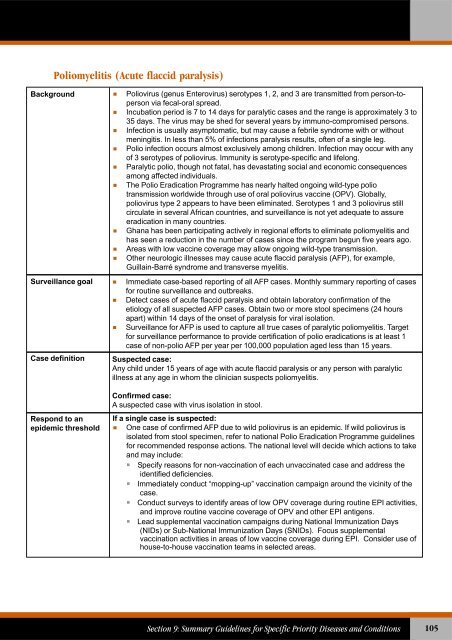Technical Guidelines for Integrated Disease Surveillance ... - PHRplus
Technical Guidelines for Integrated Disease Surveillance ... - PHRplus
Technical Guidelines for Integrated Disease Surveillance ... - PHRplus
Create successful ePaper yourself
Turn your PDF publications into a flip-book with our unique Google optimized e-Paper software.
Poliomyelitis (Acute flaccid paralysis)Background Poliovirus (genus Enterovirus) serotypes 1, 2, and 3 are transmitted from person-topersonvia fecal-oral spread. Incubation period is 7 to 14 days <strong>for</strong> paralytic cases and the range is approximately 3 to35 days. The virus may be shed <strong>for</strong> several years by immuno-compromised persons. Infection is usually asymptomatic, but may cause a febrile syndrome with or withoutmeningitis. In less than 5% of infections paralysis results, often of a single leg. Polio infection occurs almost exclusively among children. Infection may occur with anyof 3 serotypes of poliovirus. Immunity is serotype-specific and lifelong. Paralytic polio, though not fatal, has devastating social and economic consequencesamong affected individuals. The Polio Eradication Programme has nearly halted ongoing wild-type poliotransmission worldwide through use of oral poliovirus vaccine (OPV). Globally,poliovirus type 2 appears to have been eliminated. Serotypes 1 and 3 poliovirus stillcirculate in several African countries, and surveillance is not yet adequate to assureeradication in many countries. Ghana has been participating actively in regional ef<strong>for</strong>ts to eliminate poliomyelitis andhas seen a reduction in the number of cases since the program begun five years ago. Areas with low vaccine coverage may allow ongoing wild-type transmission. Other neurologic illnesses may cause acute flaccid paralysis (AFP), <strong>for</strong> example,Guillain-Barré syndrome and transverse myelitis.<strong>Surveillance</strong> goal Immediate case-based reporting of all AFP cases. Monthly summary reporting of cases<strong>for</strong> routine surveillance and outbreaks. Detect cases of acute flaccid paralysis and obtain laboratory confirmation of theetiology of all suspected AFP cases. Obtain two or more stool specimens (24 hoursapart) within 14 days of the onset of paralysis <strong>for</strong> viral isolation. <strong>Surveillance</strong> <strong>for</strong> AFP is used to capture all true cases of paralytic poliomyelitis. Target<strong>for</strong> surveillance per<strong>for</strong>mance to provide certification of polio eradications is at least 1case of non-polio AFP per year per 100,000 population aged less than 15 years.Case definition Suspected case:Any child under 15 years of age with acute flaccid paralysis or any person with paralyticillness at any age in whom the clinician suspects poliomyelitis.Respond to anepidemic thresholdConfirmed case:A suspected case with virus isolation in stool.If a single case is suspected: One case of confirmed AFP due to wild poliovirus is an epidemic. If wild poliovirus isisolated from stool specimen, refer to national Polio Eradication Programme guidelines<strong>for</strong> recommended response actions. The national level will decide which actions to takeand may include:Specify reasons <strong>for</strong> non-vaccination of each unvaccinated case and address theidentified deficiencies.Immediately conduct “mopping-up” vaccination campaign around the vicinity of thecase.Conduct surveys to identify areas of low OPV coverage during routine EPI activities,and improve routine vaccine coverage of OPV and other EPI antigens.Lead supplemental vaccination campaigns during National Immunization Days(NIDs) or Sub-National Immunization Days (SNIDs). Focus supplementalvaccination activities in areas of low vaccine coverage during EPI. Consider use ofhouse-to-house vaccination teams in selected areas.Section 9: Summary <strong>Guidelines</strong> <strong>for</strong> Specific Priority <strong>Disease</strong>s and Conditions105















